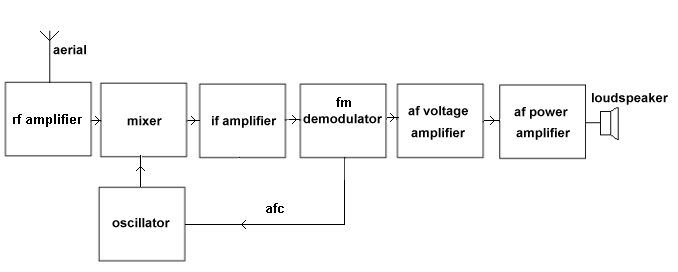| Look at the
page on THE AM RECEIVER block diagram.
Most of these
blocks are discussed individually, and in more detail, on other pages.
See filters,
mixers, frequency changers, am modulation and amplifiers.
The f.m. band
covers 88-108 MHz.
There are signals
from many radio transmitters in this band inducing signal voltages in the
aerial.
The rf amplifier
selects and amplifies the desired station from the many.
It is adjustable
so that the selection frequency can be altered.
This is called
TUNING.
In cheaper receivers
the tuning is fixed and the tuning filter is wide enough to pass all signals
in the f.m. band.
The selected
frequency is applied to the mixer.
The output of
an oscillator is also applied to the mixer.
The mixer and
oscillator form a FREQUENCY CHANGER circuit.
The output from
the mixer is the intermediate frequency (i.f.)
The i.f. is
a fixed frequency of 10.7 MHz.
No matter what
the frequency of the selected radio station is, the i.f. is always 10.7
MHz.
The i.f. signal
is fed into the i.f. amplifier.
The advantage
of the i.f. amplifier is that its frequency and bandwidth are fixed, no
matter what the frequency of the incoming signal is.
This makes the
design and operation of the amplifier much simpler.
The amplified
i.f. signal is fed to the demodulator.
This circuit
recovers the audio signal and discards the r.f. carrier.
Some of the audio
is fed back to the oscillator as an AUTOMATIC FREQUENCY CONTROL voltage.
This ensures
that the oscillator frequency is stable in spite of temperature changes.
The audio signal
voltage is increased in amplitude by a voltage amplifier.
The power level
is increased sufficiently to drive the loudspeaker by the power amplifier. |

